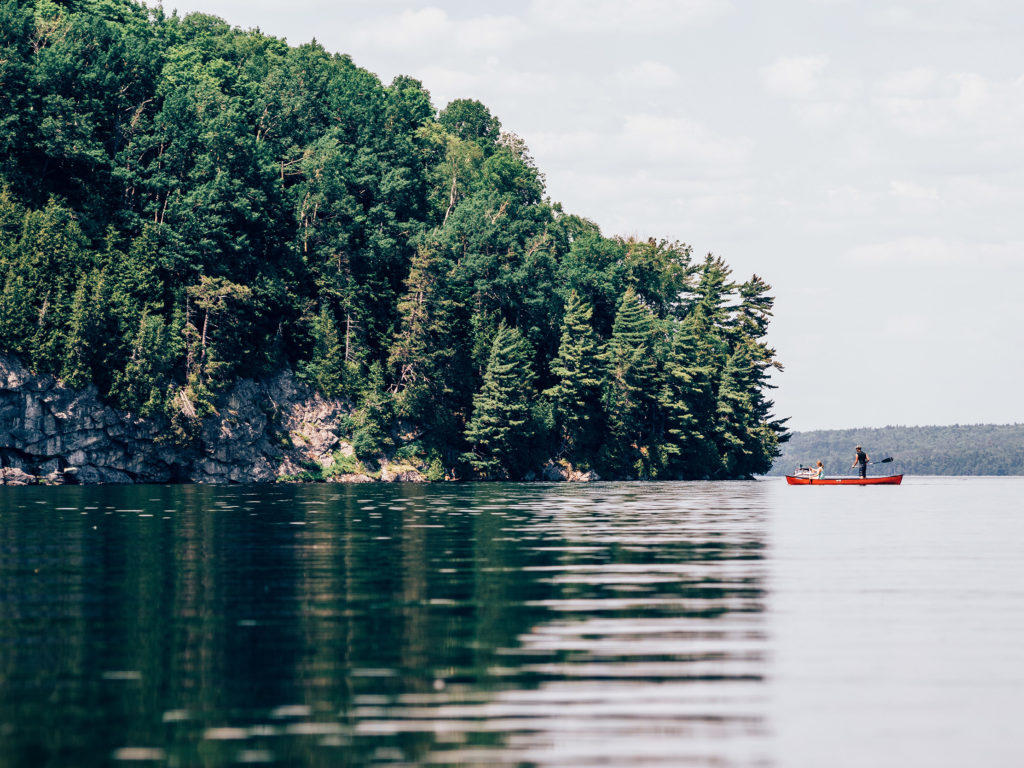On the Water: Lake Life
We can’t count all the reasons we love Maine, but 6,000 of them are the state’s lakes and ponds. As soon as the ice goes out each spring, Maine’s interior waterways begin filling with boaters. Whether you’re looking for a serene day on a quiet lake, summertime revelry, or the best places to land a fish, this guide has you covered. The first of our three-part series on boating in Maine is all about our lakes and ponds, including our favorite places to boat and how to stay safe while enjoying these precious months on the water.

Where to Go
There’s no shortage of bodies of water in Maine, so it helps to know where to go—and that depends on what you want to do when you’re out there. These are our favorite lakes to explore by boat, but we know there are many more we didn’t include. Do you have a favorite? For the chance to be included in an online roundup of reader ideas, write to us at [email protected] about where you love to get out on the water.
COBBOSSEECONTEE LAKE
This central Maine waterway is one of the best smallmouth and largemouth bassfishing lakes in all of the Northeast. But it’s not all jigging and trolling here. Cobbosseecontee has two dozen islands, including a few with public trails that are part of the Horseshoe Island Preserve and an island with the only inland lighthouse in Maine.
SEBAGO LAKE
Maine’s deepest lake—reaching 300 feet in some places—may also be its most popular, especially for boaters. You can explore its 105 miles of shoreline, including Sebago Lake State Park, visit Frye Island, and cruise through the Songo Lock to Naples’s Long Lake and causeway.
FLAGSTAFF LAKE
This lake just north of Sugarloaf and in the shadow of the Bigelows is 20 miles long but shallow. It was created from a smaller lake when the construction of a hydropower dam impounded the Dead River in 1950. If you don’t have your own boat but want to catch vistas of the Bigelows by water and learn about the lake’s history, you can book a ride with Flagstaff Lake Scenic Boat Tours.
MOOSEHEAD LAKE
Moosehead is Maine’s largest lake, and at 118 square miles it’s twice the size of Portland. This can lead to ocean-like swells in the middle of the lake, but it also means endless areas to explore, including around 80 islands. If you’re looking to dock and dine, Kelly’s Landing in Greenville is accessible by boat (and car, and seaplane . . .).
RANGELEY LAKE
Located in western Maine, Rangeley Lake has 6,300 acres of crystal-clear water ready for exploration. Boaters can visit the state park on the lake’s shore to go hiking or dock their boats there for overnight camping. Nearby Mooselookmeguntic and Richardson Lakes are also perfect for boating and just as scenic.
GREAT POND
All of the seven Belgrade Lakes are popular for boaters, but Great Pond, the largest, is home to a large marina, a yacht club, and dock-and-dine restaurants. For an especially refined dinner, tie up at the Village Inn and Tavern for the Belgrade institution’s celebrated roasted duck.
KEZAR LAKE
Kezar Lake is the kind of place that feels like it should be more well-known just because it’s so beautiful (however, the urban legend that National Geographic named it one of the three most beautiful lakes in the world is not true). The lake has managed to remain largely undeveloped, so there are plenty of unspoiled vistas from anywhere on the water.
Safety First
Lieutenant Jason Luce of the Maine Warden Service has spent most of his career patrolling the Sebago Lake Region, so he’s well versed in keeping boaters safe. On busy summer days, there can be thousands of people out on Sebago Lake, Luce says, and the Warden Service is responsible for enforcing the laws and rules of operating watercraft. (“If it happens off the pavement, there’s a good chance it belongs to us,” he says.) We asked Luce for his top tips for staying safe while boating.
WEAR A LIFE JACKET
Everyone on a boat is required to have a wearable life jacket on board, and kids under ten must be wearing one. But, since the majority of boating deaths are from drowning and wearing a life jacket significantly reduces that risk, Luce encourages everyone to wear them: “I can’t stress enough that wearing the life jacket will save lives.”
TAKE A CLASS
Luce recommends boaters—but especially inexperienced boaters—take a boating safety course. The Maine Department of Inland Fisheries and Wildlife has links to approved courses you can take online. Unlike on the road, there are no safety lines marked on the water, Luce says: “It’s completely different than operating a motor vehicle.”
DON’T DRINK AND BOAT
The same laws against driving while under the influence of alcohol also apply to operating a boat. Luce says he discourages people from bringing any alcohol on their boat—even for passengers—because lakes are technically public places. You’ll receive a warning the first time for drinking in public, but you could be summonsed if you’re caught again.
PLAN AHEAD
It’s smart to leave a note on your car or truck about where you’re going, if parking at a boat launch, or to tell someone where you’re going, Luce says. You should also look at depth maps before leaving shore, because it can be difficult to see where sunken islands and rocks are located. A lot of accidents happen because people are unfamiliar with the area and they run aground, Luce says. And, of course, fuel up: “Don’t get out in the middle of the lake and run out of gas.”








